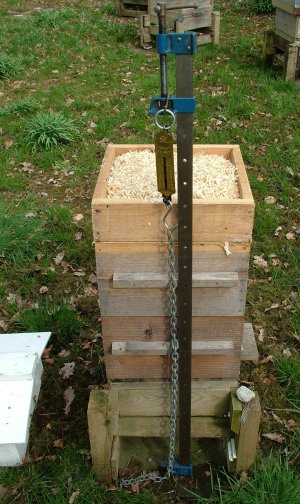
Hive Weighing Device

Above: The weighing device comprises a joiner's sash cramp (610 mm) from which is suspended a 30 kg spring balance, a chain and a hook. It is shown with a Warré hive.
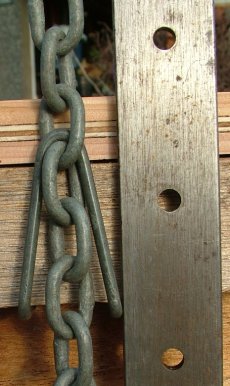
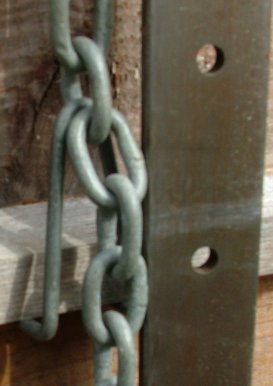
Above left: Detail of double hook (1/8 inch (3 mm) fencing wire etc) which passes through the chain and catches under a bar of a National brood box. The same equipment when used on a Warré hive is hooked under a hive body handle (above right).
Note that a small unterestimate of stores weight of about 8% is incurred by lifting a Warré box by the handle. This is described in more detail below.
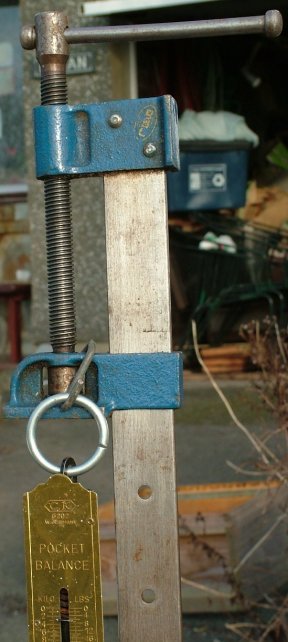
Above: Detail of top of sash cramp showing spring balance suspended from a hook (1/8 inch (3 mm) fencing wire etc) on the adjustable slide.
The sash cramp gives fine adjustment of the lift by turning the screw.
Use
Remove hive roof. Prop the device against brood box and insert hook at a point in the chain so as to allow it to be hooked under a National brood box bar or Warré box handle. While initially holding the hook in place apply tension by means of the cramp screw. Once the hook grips, apply tension with the cramp screw just clear of the box and increase tension until the box lifts no more than 1/8 inch (2-3 mm) from the hive floor and can be made to gently oscillate up and down. Use a hive tool if the floor is stuck to the box. Read the scale on the spring balance.
To calculate the stores weight, multiply the reading by 2 and subtract the weights of box, crown board, frames, comb and bees. Most of these weights to subtract can be determined beforehand or by weighing unused equipment of identical construction. The author estimates the weight of the bees as four pounds (1.82 kg) on 1 October decreasing at 0.4 pounds per month. The weight of stores given includes any pollen.
To obtain the weight of empty brood combs, a box of honey comb was harvested by centrifugation and the empty combs given back to the colony to be licked dry of honey. The resulting combs were weighed. They ranged from 80 to 181 g in weight with an average of 140 g. Allowing for the 5 mm comb left on the top-bar, which was no more than 2.5% of the whole comb, the average weight of each comb was 144 g. This means that 1152 g (2 1/2 pounds) need to be allowed for the combs in the hefting calculation.
Occasionally the weight of stores is not distributed evenly in the boxes. So a slightly more accurate method is to weigh both sides and add the weights, rather than weighing one side and multiplying by 2. See also the section on hefting underestimates below.
The cramp illustrated is expensive and probably not worth buying specially. Much cheaper options are a) aluminium sash cramp (610 mm); b) sash cramp head set (which requires a wooden batten to slide the head onto). An even cheaper solution is to replace the sash cramp with an off-centre T-bar lever, one end of which holds the spring balance, chain and hook and the other is operated by the user. This would give less fine control over the lifting, but beekeepers have used this arrangement successfully.
Example graph of National hives stores results 2004-5
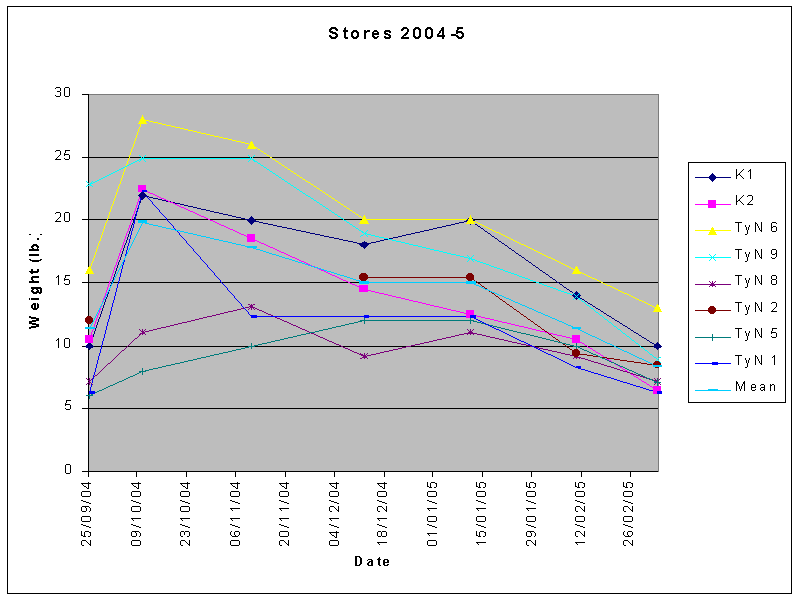
Underestimate of stores when weighing Warré boxes by this method
Jonathan Powell kindly pointed out that the above method, when applied to Warré boxes, underestimates the weight of stores. We produced a spreadsheet that allows correction of this error after input of particular local details such as box wood thickness and handle width. The error for a 2-box Warré lifted 2 mm, assuming weight is distributed evenly in the boxes, is a little under 8%. That this is an underestimate is a fail safe feature of the method. It is better to underestimate stores for the winter than overestimate them.
The Excel 97 spreadsheet is available for download as hefting_error_correction.xls .